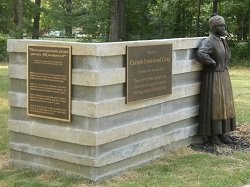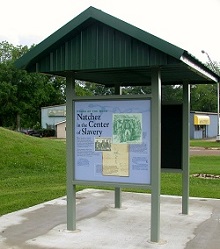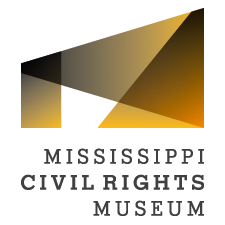

Congress Outlaws Slavery
As Southern states re-entered the Union, freed people needed legal protection of their new status. Reconstruction laws began to be enacted after the Southern states rejoined the Union. The first was the Thirteen Amendment to the Constitution, officially outlawing slavery in the United States. However, White Mississippians soon found ways to stifle Black freedom through Jim Crow laws.
Mississippi’s Slave Property
In 1823, Mississippi passed its own code to restrict slave movements and activities while protecting masters’ property rights. Enslaved people needed written permission to leave plantations. They were not allowed to buy or sell goods, hire out, own weapons, or stand in groups of five or more. If the code was broken, they faced severe punishment.
Pictured: A black and white photograph of the slave quarters of Jefferson Davis’ plantation, Brierfield. On the left is a wooden fence and bare trees. On the right is a row of wooden cabins.
Mississippi: A Slave Society
As the demand for cotton increased, the demand for more enslaved labor followed. Advertisements like these were common in newspapers throughout the South. Though Forks of the Road in Natchez was the second largest market of enslaved people, slave owners and buyers learned of sales through advertisements across the state.
Cotton Becomes King
While some Southern states’ agriculture began with tobacco, Mississippi’s cash crop was cotton. The demand for cotton boomed after the invention of the cotton gin in the 1790s. “King Cotton” caused a new demand for enslaved labor for picking. Cotton remained a staple crop in Mississippi long after the end of slavery, as newly freed people were forced to become sharecroppers.
Pictured: A black and white photograph of a street scene in Natchez. Wagons are pulled by horses through a dirt street. Various business signs can be seen in the background.
Davis Bend Plantation: Community of Cooperation
The Hurricane Plantation at Davis Bend near Vicksburg offered a rare exception to the harsh reality of slavery. The 350 enslaved people there had access to adequate food, shelter, medical care, and could read and write. However, Joseph Davis believed that “the less people are governed, the more submissive they will be to control.”
Under Colonial Rule: Le Code Noir
From 1699 to 1763, the future state of Mississippi was a part of the French colony of Louisiana. In that time, enslaved Caribbean Creoles were brought to the area, establishing a slave society long before statehood. Le Code Noir—French for Black Codes—first appeared in 1685. Though primarily used to define slavery, the Black Codes also banned Jews from French colonies and forced enslaved people to adhere Catholic practices.
Credit: John Carter Brown Library at Brown University
Corinth Contraband Camp
Corinth Contraband Camp
 Established to accommodate enslaved people who fled to safety during the Civil War
Established to accommodate enslaved people who fled to safety during the Civil War
800 North Parkway Street
Corinth, Mississippi
Forks of the Road Slave Market
Forks of the Road Slave Market
 Location of the second-largest slave market in the Deep South
Location of the second-largest slave market in the Deep South
232 St. Catherine Street
Natchez, Mississippi
Pagination
- Page 1
- Next page
